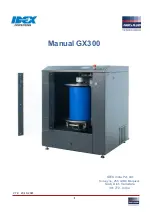
22
23
Appendix C: Specifications
Frequency Response
Mic Input to any Output (Trim at 0 dB):
+0, –1 dB,
20 Hz to 20 kHz
–3 dB,
10 Hz to 80 kHz
Distortion
THD and SMPTE IMD; 20Hz to 20kHz
Mic Input to Main Output:
< 0.005%
@ +4 dBu output
Noise
20 Hz to 20 kHz BW (150
Ω
source impedance)
Equivalent Input Noise (EIN):
–128 dBu
Residual Output Noise:
Channel & Main Mix levels off
Main, Ctrl Room, Phones:
–102 dBu
Aux 1 Monitor out
–82 dBu
Aux 2 EFX out
–92 dBu
Common Mode Rejection Ratio
(CMRR)
Mic In:
60 dB @ 1 kHz
Gain @ maximum
Crosstalk
Adjacent Inputs or Input to Output:
–85 dB @ 1 kHz
Input Gain Control Range
Mic In:
+3 dB to +50 dB
Line In:
–22 dB to + 25 dB
Phantom Power
+48 VDC
Equalization
Mono Channel EQ:
High
±15 dB @ 12 kHz
Low
±15 dB @ 80 Hz
Stereo Channel EQ:
High
±15 dB @ 12 kHz
Low
±15 dB @ 80 Hz
Mixer Rated Output
Main, Aux, Control Room:
+4 dBu
Maximum Rated Output:
+18 dBu
Maximum Input Levels
Mic Input:
+18 dBu,
Gain @ +3 dB
Inst Input:
+18 dBu,
Gain @ –22 dB
Stereo Line Input, Tape Input, and Aux Return:
+18 dBu
Maximum Voltage Gain
Mic Input to:
Main Output:
74 dB
Tape Output:
74 dB
Aux Sends:
74 dB
Control Room Output:
84 dB
Phones Output:
84 dB
Inst Input to:
Main Output:
49 dB
Tape Output:
49 dB
Aux Sends:
49 dB
Control Room Output:
59 dB
Phones Output:
59 dB
Stereo Line Input to:
Main Output:
20 dB
Tape Output:
20 dB
Aux Send:
20 dB
Control Room Output:
30 dB
Phones Output:
30 dB
Tape Input to:
Main Output:
10 dB
Tape Output:
10 dB
Control Room Output:
10 dB
Phones Output:
10 dB
Aux Return to:
Main Output:
20 dB
Tape Output:
20 dB
Aux Send:
20 dB
Control Room Output:
30 dB
Phones Output:
30 dB
Input Impedance
Mic Input:
2.3 k
Ω
, balanced
Inst Input:
1 M
Ω
Stereo Line Input:
20 k
Ω
, balanced
Stereo Aux Returns:
20 k
Ω
, balanced
CD/Tape In:
24 k
Ω
, unbalanced
Output Impedance
Main, Ctrl Room, Aux Sends:
120
Ω
Tape Output:
1 k
Ω
Phones Output:
25
Ω
Channel Level Set LED (Sensitivity)
0 dBu
(normal operating
level)
VU Meters
Main Left and Right
8 segments:
–24, –12, –4, 0, +4, +8, +12, Clip (+16)
0 LED = +4 dBu
AC Power Requirements
Internal Power Supply, standard IEC connector
Voltage Range:
U.S.:
120 VAC, 60 Hz
Europe:
240 VAC, 50 Hz
Japan:
100 VAC, 50/60 Hz
Korea:
220 VAC, 60 Hz
Summary of Contents for BLEND16
Page 1: ......
Page 7: ...7 SUB OUTS MAIN INSERT CONTROL RM OUT USB IN OUT MAIN OUT Hookup Diagrams Stereo PA system...
Page 28: ......







































